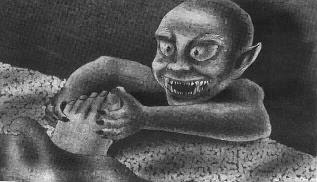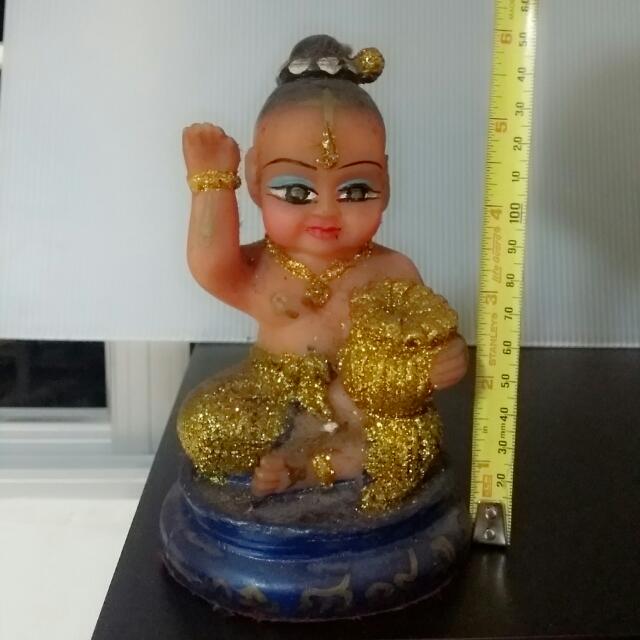
Chinese folklore features a rich variety of ghosts, monsters, and other supernatural creatures. According to traditional beliefs a ghost is the spirit form of a person who has died. Ghosts are typically malevolent and will cause harm to the living if provoked. Many Chinese folk beliefs about ghosts have been adopted into the mythologies and folklore of neighboring East Asian cultures, notably Japan and Korea.
“If from antiquity to the present, and since the beginning of man, there are men who have seen the bodies of ghosts and spirits and heard their voices, how can we say that they do not exist? If none have heard them and none have seen them, then how can we say they do? But those who deny the existence of the spirits say: “Many in the world have heard and seen something of ghosts and spirits. Since they vary in testimony, who are to be accepted as really having heard and seen them?” Mo Tzu said: As we are to rely on what many have jointly seen and what many have jointly heard, the case of Tu Po is to be accepted.
The Chinese philosopher, Mo Tzu (470–391 BCE)
Ba jiao gui (芭蕉鬼; ‘banana ghost’) is a female ghost that dwells in a banana tree and appears wailing under the tree at night, sometimes carrying a baby. In some folktales from Thailand, Malaysia and Singapore, greedy people ask for lottery numbers from the ghost in the hope of winning money. They tie a red string around the tree trunk, stick sharp needles into the tree, and tie the other end of the string to their beds. At night, the ghost appears and begs the person to set her free. In return, she will give him/her a set of winning numbers. If the person does not fulfil his/her promise to set the ghost free after winning, he/she will meet with a horrible death. This ghost is similar in some aspects to the Pontianak/Kuntilanak in Malay and Indonesian forklore
Di fu ling (地縛靈; 地缚灵; ‘Earth-bound spirit’) refers to ghosts who are bound to certain locations on Earth, such as their place of burial or a place they had a strong attachment to when they were alive.
Diao si gui (吊死鬼; ‘hanged ghost’) are the ghosts of people who died from hanging due to various reasons (e.g. execution, suicide, accident). They are usually depicted with long red tongues sticking out of their mouths.
E gui ( 餓鬼; 饿鬼; ‘hungry ghost’) refers to ghosts that appear during the Ghost Festival . They are the spirits of people who committed sins out of greed when they were alive, and have been condemned to suffer in hunger after death. The e gui is usually depicted as having green or grey skin, a mouth too small for ingesting food, and sometimes with a potbelly. The ghost suffers from insatiable hunger and roams the streets and kitchens in search of offerings and decomposed food. These hungry ghosts consume anything, including excreted waste and rotten flesh. There are various types: some have fire-breathing abilities while others suffer from anorexia.
Gui po (鬼婆; ‘old woman ghost’) is a ghost that takes the form of a peaceful and friendly old woman. They may be the spirits of amahs or servants who used to work as servants in rich families. They return to help their masters with housekeeping matters or take care of young children and babies. However, there are also evil gui pos with disgusting and violent appearances.
The jiangshi (殭屍; 僵屍; ‘stiff corpse’) is also known as the “Chinese vampire” even though it behaves more like a zombie rather than a vampire (in Western cultures). They are reanimated corpses that move by hopping around and they kill living beings to absorb their yang energy.
Nü gui (女鬼; ‘female ghost’), is a vengeful female ghost with long hair in a white dress. In folklore, this ghost is the spirit of a woman who committed suicide while wearing a red dress. Usually, she experienced some form of injustice when she was alive, such as being wronged or sexually abused. She returns to take her revenge. A tabloid story tells of a funeral ceremony where family members of a murder victim dress her in red, in the hope that her spirit will return to take revenge on her murderer. In traditional folklore, the colour red symbolises anger and vengeance. On the other hand, some ancient folktales tell of beautiful female ghosts who seduce men and suck their yang essence or sometimes kill them. This type of female ghost is likened to the Succubus. Paradoxically, the male counterpart of a nü gui, a nan gui (男鬼; : ‘male ghost’), is rarely mentioned.
Shui gui (水鬼; ‘water ghost’) are the spirits of people who drowned. They lurk in the place where they died, drag unsuspecting victims underwater, and drown them to take possession of their bodies. This process is known as ti shen (替身; ‘replace the body’), in which the spirit returns to life in the victim’s body while the victim’s spirit takes the shui gui’s place and constantly seeks to take control of another living person’s body.
Wutou gui (無頭鬼; 无头鬼;’headless ghost’) are headless ghosts who roam about aimlessly. They are the spirits of people who were killed by decapitation due to various causes (e.g. execution, accident). In some tales, the wutou gui approaches people at night and asks them where his/her head is. The wutou gui is sometimes depicted as carrying his/her head on the side.
You hun ye gui (游魂野鬼; : ‘wandering souls and wild ghosts’) refer to the wandering spirits of the dead. They roam the world of the living in the Seventh Lunar Month (typically August in the Gregorian calendar) during the Ghost Festival. These spirits include vengeful ghosts seeking revenge on those who offended them before, hungry ghosts and playful spirits who might cause trouble during that period. The Chinese Idiom gu hun ye gui ( 孤魂野鬼; ‘lonely souls and wild ghosts’), which describes such spirits, is also used to refer to homeless people or those who wander around aimlessly.
Yuan gui (冤鬼; ‘ghost with grievance’) are the spirits of persons who died wrongful deaths. Beliefs in such ghosts had surfaced in China from as early as the Zhou dynasty and were recorded in the historical text Zuo Zhuan. These ghosts can neither rest in peace nor be reincarnated. They roam the world of the living as depressed and restless spirits who constantly seek to have their grievances redressed. In some tales, these ghosts approach living people and attempt to communicate with them to lead them to clues or pieces of evidence that point out that they died wrongful deaths. The living people then try to help them clear their names or otherwise ensure that justice is served.
Ying ling (嬰靈; 婴灵; ‘infant spirit’) refer to the spirits of dead fetuses. People rare baby spirits to help them do things. We can write more about baby spirits in our next blog post.
Zhi ren (紙人; 纸人; ‘paper person’) are dolls made from paper that are burnt as offerings to the dead to become the deceased’s servants. These dolls usually come in pairs – one male and one female – and are sometimes called jin tong yu nü (金童玉女; ‘golden boy and jade girl’). These dolls are not exactly spirits by themselves, but they can do the bidding of their deceased masters.
Zhong yin shen (中陰身; 中阴身; ‘intermediate yin body’) refers to a spirit in a transition state between his/her death and when he/she is reincarnated as described in Mahayana Buddhism. This period of time is usually 49 days.
In the Śūraṅgama Sūtra, ghosts are depicted as the souls of wicked humans who, after undergoing punishment for their offenses in the afterlife, are eventually reborn as demons. Like the immortal xian, the text describes ten types of ghosts, characterizing each type with their principal offense and their unique ability.
- Weird ghosts (怪鬼; 妖鬼; ) were consumed by materialism in life and can transform into any physical object.
- Drought ghosts (魃鬼; ) were consumed by carnal lust in life and can create hot, dry winds.
- Trickster ghosts (魅鬼; ) caused confusion in life and can transform into animals.
- Venomous ghosts (蠱毒鬼; ) were hateful to others in life and can transform into insects.
- Pestilence ghosts (疠鬼; ) harbored grudges in life and can cause disease and decay.
- Hungry Ghosts (饿鬼; ) were arrogant in life and can take on gaseous forms.
- Nightmare ghosts (魘鬼; ) were frauds in life and can transform into pure darkness.
- Goblin ghosts (魍魉鬼; ) were corrupted by their desire for insight in life and are formed from the essential energy within rocks and trees.
- Servant ghosts (役使鬼; ) were corrupted by their desire for accomplishment in life and can transform into blinding light.
- Messenger ghosts (传送鬼; ) were litigious in life and can transform into any person.
Another classification is mentioned in A Dictionary of Chinese Buddhist Terms (翻譯名義集; Fānyì Míngyì Jí). There are nine types of hungry ghosts, all divided into three main classes:[16][17]
- Ghosts without means (無財鬼; ):
- Torch-mouth ghosts (炬口鬼; ) have mouths like burning torches.
- Needle-mouth ghosts (針口鬼; have mouths no bigger than needles, so they cannot satisfy their hunger or thirst.
- Foul-mouth ghosts (臭口鬼; ) have vile breath, disgusting even to themselves.
- Ghosts with small means (少財鬼; ):
- Needle-hair ghosts (針毛鬼; ) have hair like iron needles, distressing to themselves and others.
- Smelly-hair ghosts (臭毛鬼; ) have spike-like hair that emits an awful odor.
- Tumour ghosts (癭鬼; ) have large goiters on whose pus they must feed.
- Ghosts with excessive means (多財鬼; ):
- Ghosts hoping for offerings (希祀鬼; ) live on sacrificial offerings, usually from their descendants.
- Ghosts hoping for leavings or ghosts that inhale energy (吸氣鬼; 希棄鬼; ) eat any human leftovers, and can even devour the qi of living beings.
- Ghosts of great powers (大勢鬼; ) are powerful rulers of ghosts (like yakshas, rakshasas, pishachas, etc.), who are perpetually aggressive and violent.







